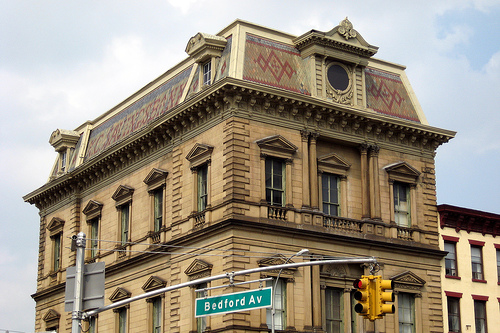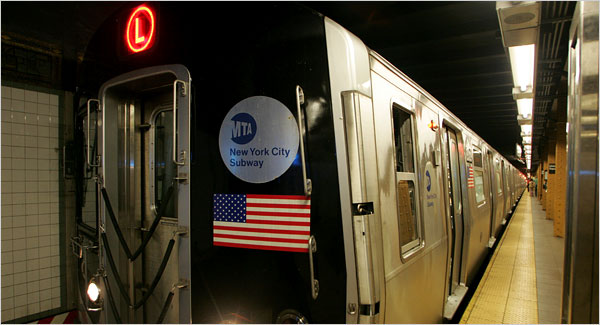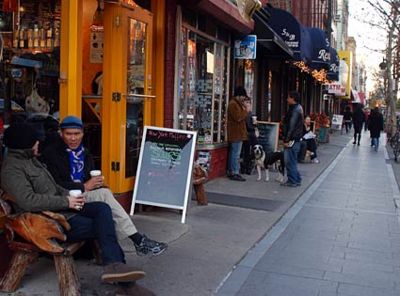From The Peopling of New York City
Contents |
A Neighborhood in Transition
Many recent changes have transformed the face of Williamsburg. What used to be a poverty-stricken, crime and drug-infested district is changing into one of the most “hip” and desirable neighborhoods to live in. Today, Williamsburg is the home to a diverse group of people – Italians, Polish, Hispanics, and Hasidic Jews.
A Brief History
Before Brooklyn became part of NYC, the City of Williamsburg, in 1855, was annexed into the City of Brooklyn, as the “Eastern District”. During this period, the region enjoyed many economic and industrial achievements. Wealthy New Yorkers began settling here in their mansions. Companies like Pfizer Pharmaceuticals, which still has an industrial plant in the neighborhood. At one point, Williamsburg possessed 10% of the wealth of the United States. Factories like the Domino Sugar, Esquire Shoe Polish, and Dutch Mustard were established in the 19th and 20th century. Many of the factories have been converted to residential or cultural buildings. The Kings County Savings Institution was opened on April 10,1860. The bank was used by the wealthiest men in America.
Brooklyn Becomes One of the Five Boroughs
In 1898, Brooklyn became part of New York, opening many connections between Williamsburg and the rest of the city. The opening of the Williamsburg Bridge in 1903 significantly impacted the area’s demographics. Thousands of Jewish immigrants fled the revolting conditions of the Lower East Side to start a better life. Soon, Williamsburg became the most densely populated neighborhood in the United States. After WWII, however, the economy declined. Refugees like the Hasidic Jews from Europe began settling south of Division Avenue, which holds an established Satmar Hasidic sect today. In the 1960s, Hispanics like Puerto Ricans and Dominicans moved here to work in factories and refineries. Williamsburg became an immigrant ghetto as industries began leaving the area by the next decade. However, the neighborhood was soon plagued by poverty, crime, and illegal drugs which exacerbated the depletion of industry and increase of population. Those who could afford to move out, like some Italian and Jewish residents did, leaving behind the impoverished targets of economic and social evils.
The L Train
The Canarsie line runs between 14th Street in Manhattan and Canarsie in far-eastern Brooklyn. Along the way, it stops in Williamsburg, Bushwick, and East New York. Ridership on the L train has increased dramatically -- more than expected, since 2000. Annual ridership for the L service:[1] 1994 . . . 16,968,025 1996 . . . 18,107,243 1998 . . . 21,196,693 2000 . . . 26,155,806 2005 . . . 30,452,319
With the recent improvements made on the L train -- introduction of a communications-based control, by which computers were supposed to be able to tell where trains are and when they’re supposed to arrive at a station; and brand-new, clean cars, with illuminated route maps flashing information. Several stations on the eastern end of the line have been renovated as well.[2] This progress is both an outcome and a cause of growing gentrification in Williamsburg. The L train is enabling artists and hipster to move in deeper into Brooklyn. In the past year, condo purchase prices have increased 30 percent and one-bedroom rentals have gone up 10 percent at most of the L stops.[3]
Results of Gentrification
The movement of artists and professionals in the neighborhood has worried old residents for quite some time now. The poor, working-class Hispanics fear that this migration of people from Manhattan will drive them out of their locality, as rents rise dramatically. Meanwhile, the Hasidic community has expressed an outcry of strong resentment against the "invasion" of the artists. In order to maintain their Jewish identity, they feel it is important to stay isolated from American mainstream culture, which will only corrupt them. According to Hasidic Jews, Hipsters only contribute to the skyrocketing rents and an immoral lifestyle. As a result, resources and housing becomes scarce and competition between the two most prominent groups in Williamsburg -- the Hispanics and Hasidics -- has heightened. Legal disputes between the two groups have taken place over housing and government funds.
The Other Side of the Story
While there have been protests against the Hipster movement into Wiliamsburg, artists believe that they are actually a good influence on the neighborhood. Many live paycheck to paycheck, without health insurance and public insurance. Their efforts have been beautifying the neighborhood, reducing pollution, and making it more attractive; therefore, rents like $350 cannot exist because the area is becoming a better place to live in. "Enough about those who pay almost nothing to live in one of the best places in the world. You don’t see my peers thinking it’s unfair that we are constantly struggling and barely making ends meet. At the end of the day, we are poorer than you", a blog-entry by a hipster said.
[4]- ↑ http://www.mta.info/nyct/service/lline.htm
- ↑ http://www.nytimes.com/2008/01/22/realestate/22comm.html?_r=1&ref=realestate&oref=slogin
- ↑ http://nymag.com/nymetro/realestate/neighborhoods/features/14884/
- ↑ http://images.google.com/imgres?imgurl=http://www.urban75.org/photos/newyork/images/williamsburg-026.jpg&imgrefurl=http://www.urban75.org/blog/2007_03_01_archive.html&h=285&w=425&sz=25&hl=en&start=26&tbnid=_FIB95fNefwSlM:&tbnh=84&tbnw=126&prev=/images%3Fq%3Dwilliamsburg,nyc%2Bin%2Bthe%2B1960%2527s%26start%3D20%26gbv%3D2%26ndsp%3D20%26hl%3Den%26sa%3DN



